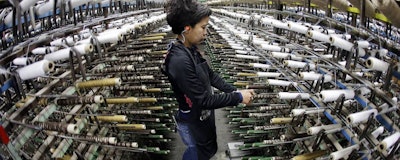
Economic activity in the manufacturing sector expanded in February, and the overall economy grew for the 93rd consecutive month, say the nation’s supply executives in the latest Manufacturing ISM Report On Business.
Manufacturing expanded in February as the PMI registered 57.7 percent, an increase of 1.7 percentage points from the January reading of 56 percent, indicating growth in manufacturing for the sixth consecutive month, and is the highest reading since August 2014, when the PMI registered 57.9 percent. A reading above 50 percent indicates that the manufacturing economy is generally expanding; below 50 percent indicates that it is generally contracting.

Bradley J. Holcomb, CPSM, CPSD, chair of the Institute for Supply Management Manufacturing Business Survey Committee states, “The past relationship between the PMI and the overall economy indicates that the average PMI for January through February (56.9 percent) corresponds to a 4.3 percent increase in real gross domestic product (GDP) on an annualized basis. In addition, if the PMI for February (57.7 percent) is annualized, it corresponds to a 4.5 percent increase in real GDP annually.”
A PMI above 43.3 percent, over a period of time, generally indicates an expansion of the overall economy. Therefore, the February PMI indicates growth for the 93rd consecutive month in the overall economy and the sixth straight month of growth in the manufacturing sector.
Orders, Production and Inventory
ISM’s New Orders Index registered 65.1 percent in February, which is an increase of 4.7 percentage points when compared to the 60.4 percent reported for January, indicating growth in new orders for the sixth consecutive month. It is the highest reading since December 2013, when the New Orders Index also registered 65.1 percent. A New Orders Index above 52.3 percent, over time, is generally consistent with an increase in the Census Bureau’s series on manufacturing orders (in constant 2000 dollars).
“New Orders is really a reflection of two things: consumer confidence and consumer activity,” explains Holcomb. “People are feeling good about the economic environment. There’s a high employment level and people with paychecks to go buy things they want and need. That activity is reflected in New Orders and is driving this system.”
ISM’s Production Index registered 62.9 percent in February, which is an increase of 1.5 percentage points when compared to the 61.4 percent reported for January, indicating growth in production for the sixth consecutive month. It is the highest reading since March 2011, when the Production Index registered 64.2 percent. An index above 51.4 percent, over time, is generally consistent with an increase in the Federal Reserve Board’s Industrial Production figures.
The Inventories Index registered 51.5 percent in February, which is an increase of 3 percentage points when compared to the 48.5 percent reported for January, indicating raw materials inventories are growing in February for the first time following 19 consecutive months of contraction. An Inventories Index greater than 42.9 percent, over time, is generally consistent with expansion in the Bureau of Economic Analysis (BEA) figures on overall manufacturing inventories (in chained 2000 dollars).
ISM’s Backlog of Orders Index registered 57 percent in February, an increase of 7.5 percentage points from the 49.5 percent reported for January, indicating growth in order backlogs for the first month following seven consecutive months of contraction. It is the highest reading since March 2014, when the Backlog of Orders Index registered 57.5 percent. Of the 88 percent of respondents who reported their backlog of orders, 26 percent reported greater backlogs, 12 percent reported smaller backlogs, and 62 percent reported no change from January.
Exports, Imports and Prices
ISM’s New Export Orders Index registered 55 percent in February, an increase of 0.5 percentage point when compared to the 54.5 percent reported for January, indicating growth in new export orders for the 12th consecutive month.
ISM’s Imports Index registered 54 percent in February, an increase of 4 percentage points when compared to the 50 percent reported for January, indicating that imports are growing in February relative to January.
“Prices are certainly continuing with high index numbers increasing for 12 consecutive months, so it is really something we need to watch in terms of its potential to reflect inflation,” says Holcomb. “We’re not there yet, but we do one comment from Electrical Equipment, Appliances & Components, ‘Major focus on commodities and potential [for] further inflation.’ So the index is at a high level and we’d like to see that come off or certainly not go up, but we’ll just have to see. At the moment we’re not concerned, but it should be watched.”
The ISM Prices Index registered 68 percent in February, a decrease of 1 percentage point when compared to the January reading of 69 percent, indicating an increase in raw materials prices for the 12th consecutive month. In February, 41 percent of respondents reported paying higher prices, 5 percent reported paying lower prices, and 54 percent of supply executives reported paying the same prices as in January. A Prices Index above 52.4 percent, over time, is generally consistent with an increase in the Bureau of Labor Statistics (BLS) Producer Price Index for Intermediate Materials.
Employment
ISM’s Employment Index registered 54.2 percent in February, a decrease of 1.9 percentage points when compared to the January reading of 56.1 percent, indicating growth in employment in February for the fifth consecutive month. An Employment Index above 50.5 percent, over time, is generally consistent with an increase in the Bureau of Labor Statistics (BLS) data on manufacturing employment.
The monthly Manufacturing ISM Report on Business is based on the survey results of approximately 350 professionals across 18 different industry sectors. The report is released on the first business day of each month and features the PMI Index as its key measure. For more information on the Institute for Supply Management, visit www.ism.ws.






















